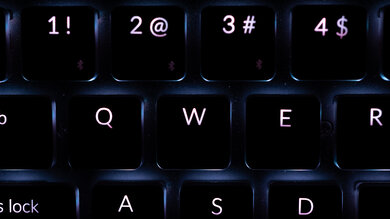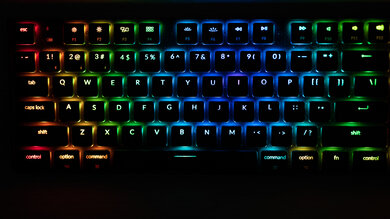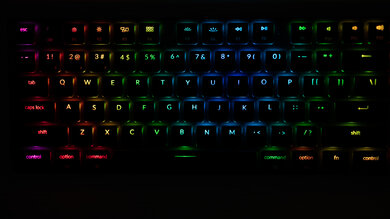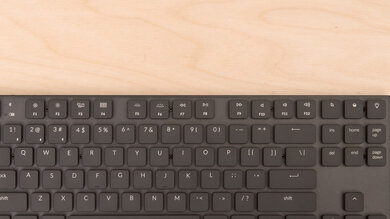The Keychron K1 is a decent wireless mechanical keyboard for most uses. It's made largely of aluminum, giving it a sturdier feel and an overall comfortable experience. Our unit has Gateron Low Profile Red switches that don't require a lot of force to actuate and have a low pre-travel distance, resulting in a responsive typing experience. Unfortunately, the latency is only decent over a wired connection and terrible over Bluetooth. Also, there's no companion software to customize the RGB lighting, and there aren't any macro-programmable keys. On the upside, you can use it wirelessly over Bluetooth and pair it with up to three devices at the same time.
Note: Some variants of this keyboard can be difficult to find through retailers, but they can be purchased directly from Keychron's website.
Our Verdict
The Keychron K1 is a decent keyboard for gaming. The Gateron Low Profile Red switches don't require a lot of force to actuate and have a low pre-travel distance. It has a great build quality, with most of the keyboard being made of aluminum with little to no flex. However, there's no companion software or macro-programmable buttons. The latency is only decent, which may not be ideal for competitive gaming.
- RGB backlighting.
- Responsive switches.
- Great build quality.
- No macro-programmable keys.
- No companion software.
The Keychron K1 is a great keyboard for using with your smartphone or tablet. You can pair it over Bluetooth with your mobile device and it can be paired with up to three devices at once. While it's a fairly light keyboard, it's also rather wide, making it less than ideal to travel with.
- Bluetooth support.
- Multi-device pairing.
- Great build quality.
- No companion software.
- Bulky.
The Keychron K1 is a satisfactory keyboard for office use. Ergonomics are only decent, as it lacks a wrist rest and there are no incline settings. While the switches help provide a responsive typing experience, the flat ABS keycaps are slippery and are bunched together, which can lead to an increase in typos.
- Bluetooth support.
- Responsive switches.
- Great build quality.
- No wrist rest or incline settings.
- Compact and tight key layout.
- No companion software.
The Keychron K1 is a satisfactory keyboard for programmers. While it offers a decent typing experience due to the responsive switches, the keycaps are made of ABS plastic that feels cheap and they're prone to feeling slippery. Also, it doesn't have macro-programmable buttons. That said, it has a solid aluminum frame and full RGB backlighting which can be modified via a button directly on the keyboard.
- RGB backlighting.
- Responsive switches.
- Great build quality.
- No macro-programmable keys.
- Compact and tight key layout.
- No companion software.
The Keychron K1 is only okay for use with a home theater PC. It's wireless, so you won't need to worry about a keyboard wire in your setup. Also, it has media keys and backlighting. However, it doesn't have an integrated trackpad like some dedicated HTPC keyboards.
- Bluetooth support.
- RGB backlighting.
- No companion software.
- No integrated trackpad.
Changelog
- Updated Feb 08, 2021: Converted to Test Bench 1.0.
- Updated Sep 23, 2020: Review published.
- Updated Aug 17, 2020: Early access published.
- Updated Aug 03, 2020: Our testers have started testing this product.
Check Price
Differences Between Sizes And Variants
Our Keychron K1 is a TenKeyLess (TKL) keyboard with Gateron Low Profile Red switches, but it's also available with Gateron Low Profile Blue and Brown switches. There's also the Keychron K1 SE, which is an updated version of this board. It has two incline settings, made of plastic and aluminum, and it has a hot-swappable variant with Low Profile Gateron switches. You can see all the differences in the table below.
| Model | Material | No. of Incline Feet | Backlighting | Switches | Hot-swappable |
|---|---|---|---|---|---|
| K1 | Full aluminum body | 0 | White, RGB | Low Profile Gateron Mechanical Red, Blue, Brown | No |
| K1 | Full aluminum body | 0 | White, RGB | Low Profile Keychron Optical Red, Blue, Brown | Yes |
| K1 SE | Plastic bottom case with aluminum top plate | 2 | White, RGB | Low Profile Gateron Mechanical Red, Blue, Brown | No |
| K1 SE | Plastic bottom case with aluminum top plate | 2 | White, RGB | Low Profile Gateron Mechanical Red, Blue, Brown | Yes |
| K1 SE | Plastic bottom case with aluminum top plate | 2 | White, RGB | Low Profile Keychron Optical Red, Blue, Brown | Yes |
We expect these results to be valid for the other variants, aside from typing experience. The label for our unit can be seen here.
Popular Keyboard Comparisons
The Keychron K1 is a TenKeyLess keyboard that's ideally suited for typing on your tablet or smartphone. Despite having no incline settings or wrist rest, it's a comfortable keyboard to type on when compared to the Keychron K4, which has a higher profile. It can be used wirelessly over Bluetooth, just like the Logitech MX Keys, but the K1 has full RGB backlighting while the Logitech only has a white backlight. It's also cheaper than the Logitech G915 LIGHTSPEED, another low-profile mechanical keyboard that uses similar switches.
For other options, you can also check out our recommendations for the best RGB keyboards, the best wireless keyboards, and the best mechanical gaming keyboards.
The Keychron K2 (Version 2) and the Keychron K1 are both compact wireless keyboards, but the K1 uses low-profile switches, whereas the K2 uses standard switches. Also, the K1 is slightly longer since it has a TKL layout instead of a compact 75% like the K2. The tactile Gateron Brown switches on our K2 unit offer a better typing experience than the linear Gateron Low Profile Red switches on our K1 unit. While K2's wired latency is marginally worst than the K1, its Bluetooth latency is significantly better. Neither come with customization software.
The Keychron K1 and the Keychron K8 are both wireless TenKeyLess keyboards with similar features. The main difference is that the K1 uses low-profile switches, whereas the K8 uses standard switches. The K8 has slightly lower latency, but not by much. Neither have customization software to change the backlighting or to set macros.
The Logitech MX Keys is a better office keyboard than the Keychron K1. The Logitech has scissor switches that provide a better typing experience, but the keys do require a bit more force to actuate than the Keychron. Also, it uses the Logitech Options companion software and is fully compatible with macOS and Windows. That said, the Keychron has full RGB backlighting, whereas the Logitech has white backlighting.
The Keychron K1 and the Keychron K3 are both great gaming keyboards, but the K1 has a TenKeyLess layout whereas the K3 has a compact 75% layout. Otherwise, they have very similar features, although the K3 has a lower latency over Bluetooth. It also has a Caps Lock indicator light, which the K1 lacks. The K3 is available with many different switches, including optical ones, so you have a wider range of options to choose from. Neither keyboards have software to customize the backlighting or set macros.
Test Results

This is a TenKeyLess (80%) keyboard that lacks a Numpad but still includes a 'Print Screen', 'Insert', and two unique buttons for Cortana and Siri. If you like low-profile switches but want something even more compact, the Keychron K3 is a good option.
This keyboard has decent ergonomics. Despite having no incline settings or wrist rest, its low profile is overall quite comfortable, with only minor fatigue being felt. However, if you want a more compact low-profile keyboard with two incline settings, check out the Keychron K7.
This keyboard has outstanding RGB backlighting. While there's no companion software, there's a handy customization button on the top right-hand side, where you can modify the pre-programmed effects and colors. It's good at color mixing since you don't see too many other colors when setting the backlighting to white.
It comes with a detachable USB-C cable that feels cheap and wobbles in the keyboard port.
The Keychron K1 has wireless Bluetooth support. It has a built-in rechargeable battery. It can be paired with up to three different devices at once and switching between them is done by sliding a button on the top of the board.
The Keychron K1 doesn't have too many extra features. There are media hotkeys and buttons to summon Siri or Cortana, but we couldn't get them to pop up. Also, there are no macro-programmable keys.
Our Keychron K1 model uses Gateron Low Profile Red switches, which provide linear feedback. There isn't a lot of pre-travel distance until the key is actuated, resulting in a responsive typing experience. If this isn't to your liking, you can get it with tactile Gateron Low Profile Brown or clicky Low Profile Blue switches. If want a TenKeyLess board with standard-sized switches, check out the Keychron K8.
Typing on this keyboard is decent. The Gateron Low Profile Red switches on our unit provide linear feedback. Since the ABS keycaps are slippery, typos are more prevalent. Also, the lack of any incline settings and the taller-than-normal profile for this design resulted in some minor fatigue. If you don't want Red switches, you can get it with loud and clicky Gateron Low Profile Blue switches. The keys aren't as well-spaced as the Apple Magic Keyboard 2017, but if you're a fan of mechanical switches, it's a decent choice.
The linear Gateron Low Profile Red switches on our unit are quiet and shouldn't bother anyone around you even when in a noise-sensitive environment. However, the board may be louder if you get a different switch type, like the Gateron Low Profile Blue switches or the Gateron Low Profile Brown switches.
The latency on the Keychron K1 is decent over a wired connection and shouldn't be noticeable to most people, but it may not be ideal for competitive gaming. If you use the keyboard over Bluetooth, the latency is very high.
Unfortunately, there's no customization software available for this keyboard. Keychron lists some third-party options in their user manual, but they're not officially supported, and we haven't tested them.
The Keychron K1 has very good compatibility options. There are a few issues on each operating system that prevent it from being fully compatible. Most of these issues have to do with function keys not working, like the Cortana button not working on Windows, Siri not working on macOS, and F1 and F2 not working on both. There's a 'Print Screen' button, but that only works on Windows.









